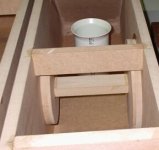A few years ago I came up with a system for making my cabinets panels less resonant. It is easy, cheap and effective. If you cut rings of sonotube about 1" to 2" inches in height in several different diameters and using a rigid glue, glue them to the insides of the cabinet sides you will create a panel that resonates as if it is much thicker than it really is. These rings take up very little volume and also break up standing waves. Using 2 or 3 concentric rings offset from center does the job. The sonotube ring is incredibly rigid along its height and as a circle is self supporting unlike a straight brace which can twist. Try it, you'll like it!😎
Erm OK I like the sound of that , Im going to be building a enclosure in the close future and I will try it out.
However there is one problem, I live in the UK where can I buy sonotube or an equivelent over the other side of the pond.
Cheers
However there is one problem, I live in the UK where can I buy sonotube or an equivelent over the other side of the pond.
Cheers
Try a concrete supplier as they are used as former tubes for concrete pillars.5th element said:Erm OK I like the sound of that , Im going to be building a enclosure in the close future and I will try it out.
However there is one problem, I live in the UK where can I buy sonotube or an equivelent over the other side of the pond.
Cheers
It takes up too much internal volume and I found that it is less effective than the rings.rabbitz said:Instead of throwing away your driver cutouts, glue them on the inside of the side panels offset from the centreline. Works well and costs nothing.
I add the volume of these in my calcs. Could always route concentric grooves in the cutouts if you want to save on volume.
Just want to clarify one thing. These Sonotubes are made out of paper?
Are all these Sonotube advocates saying that just using a paper tube is what we need for enclosures and bracing?
Or are there plastic Sonotubes as well?
If paper is in fact the material, (and the concrete forms I see in the home improvement stores all are made of paper), then do we reinforce the paper in some way to add stiffness?
I know that the cylinder is an intrinsically stiff shape, but still.......paper.
Are all these Sonotube advocates saying that just using a paper tube is what we need for enclosures and bracing?
Or are there plastic Sonotubes as well?
If paper is in fact the material, (and the concrete forms I see in the home improvement stores all are made of paper), then do we reinforce the paper in some way to add stiffness?
I know that the cylinder is an intrinsically stiff shape, but still.......paper.
Apparently, the cylindrical concrete forms they sell in Home Depot, (giant American home imporvement store chain) are significantly flimiser than the genuine Sonotube:
http://astro.umsystem.edu/atm/ARCHIVES/JUN98/msg00149.html
Here is the real stuff.
http://www.concreteacc.com/sonotube.asp
I saw the concrete tubes at Home Depot, and it struck me that they simply were too flimsy for enclosures. Perhaps the genuine article is different.
http://astro.umsystem.edu/atm/ARCHIVES/JUN98/msg00149.html
Here is the real stuff.
http://www.concreteacc.com/sonotube.asp
I saw the concrete tubes at Home Depot, and it struck me that they simply were too flimsy for enclosures. Perhaps the genuine article is different.
The real sonotubes are very rigid compared to the junk home depot sells. Also remember, the rigidity is along the length. Try and take a piece of paper and bend it along its height lying it flat on a surface. You cant do it.
Are all these Sonotube advocates saying that just
using a tube is what we need for enclosures and bracing?
They are only good for relatively squarish panels. For long
panels full length and side to side bracing is much better.
🙂 sreten.
- Status
- Not open for further replies.
- Home
- Loudspeakers
- Multi-Way
- Panel resonance control
